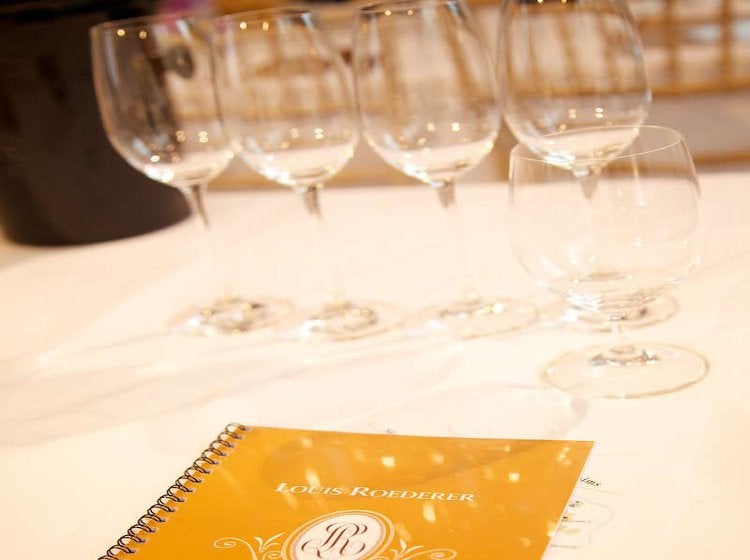
One of the few remaining great family houses of Champagne, Louis Roederer has one priceless asset that its rivals lack: Almost every one of its Vintage cuvées-certainly the magnificent Cristal-is made exclusively from grapes grown in its 230ha (568 acres) of enviably placed vineyards on the Montagne de Reims, the Côte des Blancs, and the Grande Vallée de la Marne; these holdings also supply two thirds of the house’s needs for the Roederer Brut Premier NV. Such a high proportion of “estate” grapes is very rare in a grande maison, giving inherently superior quality and control at every stage of production.
This explains why Roederer can often release Vintages earlier than its rivals, based on wine maestro Jean- Baptiste Lécaillon and his team’s intimate knowledge of the optimally ripe parcels within the predominantly grand cru structure of the estate.
Actually, the modern trend toward a more parcel-by-parcel approach to Champagne-making is nothing new at Roederer. As early as 1845, the family realized this concept in its choice of vineyard sites in creating a highly distinctive Vintage style based on the chalkiest, coolest, and most durable plots of the northern Montagne at Verzenay and Verzy: V & V, the heavenly twins, have always been about density of texture, intensity of mineral flavors, and potential for long aging. Such is their strong personality, says Lécaillon, “the terroir takes over from the varietal characteristic.”
Introducing this tasting, Lécaillon also gave us his thoughts about ideal disgorgement dates and adaptions in vineyard husbandry and winemaking techniques-set against the backcloth of climate change in warmer autumns but also mercurial weather patterns, especially chaotic distribution of rainfall. “Our wines are much riper than they were 15 years ago, so they don’t need to remain on lees (for the richness these give) for much more than three to four years now.” A diplomatic way of saying that he is not a fan of latedisgorgement. To guard compensating freshness, several of the best Vintage cuvées are made wholly or partially avoiding the malo. But Lécaillon’s real long-term achievement is likely to be his measured introduction of organic viticulture. Going further, Roederer’s 40ha (100 acres) of biodynamically cultivated plots within the estate is the largest development of its kind in Champagne. No one understands better than Lécaillon’s team the fundamental paradox of winemaking in the Marne, subject as it is to maritime and continental influences in contrasting vintages. “In an ‘Atlantic’ vintage like 2011, I’ve no doubt that the biodynamic parcels were the most successful; in riper ‘continental’ years (2005, 2002) I’m not so sure,” is Lécaillon’s insight. The tasting was divided into three.
The Vintage rosés were shown rightly in the bloom of youthful fruit. At Roederer, they are made in a special way: the Pinot Noir berries are cold soaked in their juice, to which is added a touch of Chouilly Chardonnay. The encépagement for Vintage whites is 70% Pinot Noir / 30% Chardonnay. Dosage nowadays is 8-10g/l (formerly 12g/l).
Brut Rosé
2007 A mercurial growing season, hot spring but a damp, prolonged period from flowering to harvest start (107 days). Bright salmon, an ‘Atlantic,’ delicately scented vintage, fresh, attractive, minerally. Slight lack of flesh but pure, kinetic, and persistent. 16.5 2006 Similar subtle color to ’07 but a much more generous wine from a dry, hot summer, Pinot Noir the king. Lovely orchard-fruits nose; hedonistic, gras, with compensating freshness and elegant acidity. 17.5
Brut Vintage
2006 Strong classic assemblage Vintage, optimally ripe, so no malolactic in order to protect balance of succulent Pinot-dominant fruit and finely textured energy and fresh vigor. Still young, it will develop further power in tune with creaminess from a slight touch of surmaturité. Lovely. 2012-18. 18
2002 Large-cask fermentations, maturing elegant scents of vanilla and lanolin mingled with confit of yellow/red fruits. Still very youthful palate; this is a giant in a mid-life sleep, more wine than Champagne, dense and concentrated. Huge potential. 19 1996 Fruit and acids still circle each other warily, much too sinewy, something it will never lose? Picked maybe a week too early. A tad disappointing. 15
1988 Developed gold. Wonderful nose of truffles, iodine, and salt. The fruit stays fresh, the structure precise. Lingering vinosity. 18.5 Cristal
2005 Very much a ‘continental’ style of Cristal in a particularly hot harvest. The sun gave an opulent Burgundian texture and creaminess, checked by minerality-akin to Corton-Charlemagne with bubbles. Brilliant winemaking in a difficult vintage. 18
2004 More maritime influences. Purity, elegance are the watchwords in aromatic, linear loveliness-delicacy and subtle richness in complete balance. Already highly pleasurable-will keep at this level for some years. 18.5, edging higher
1999 (Jeroboam) If this is possible for Cristal, ’99 has always been a crowd-pleaser rather than a classic-rich, golden fruit its main charm. Even in Jeroboam, it tastes almost à point, and I’d drink it soon. The lowest acidity since 1989. 17
1990 A perfect season for ripeness and acidity. The wine’s greatness is still assured, with myriad complexities. However, this late-disgorgement (2008) makes, I believe, for flatter end flavors. Food for thought. 17
Cristal Rosé
1996 More golden than pink-the subtlest hue. A huge challenge to make, the pH very low at 2.8-the textbook said that the yeasts couldn’t function. De-acidification didn’t work, so in the end the team just made the wine au naturel. A miracle of ethereal scented flavors, with depth. Bravissimo! 19






